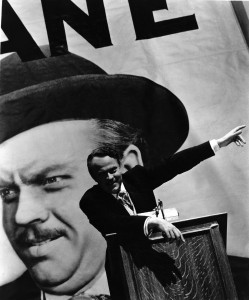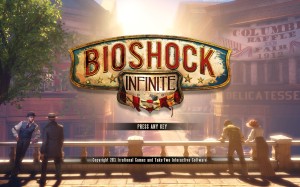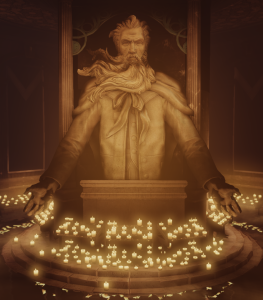BioShock Infinite Review
by RadiumEyes, HSM team writer
“I am Andrew Ryan, and I am here to ask you a question.”
These words, spoken by the founder of Rapture, play over a scratchy image of Ryan, nonchalantly sitting in his office, directly facing the camera; he’s addressing you as well the character you play as you descend into the ocean via bathysphere to enter the city he so meticulously planned. The bathysphere’s slow travel into Rapture, one discovers, parallels the slow descent into madness that culminated into a revolt on New Year’s Day, 1959 – the year before the protagonist discovers the lighthouse. Welcome to Bioshock.
The game begins with a plane crash, and the spectacular undersea discovery of a dystopian world inhabited by grotesque-faced individuals who wreak havoc on the city they call home. Rapture no longer follows Andrew Ryan’s dream of an individualistic pursuit, “unburdened” by major social and political bodies such as Congress and the Vatican. In fact, it represents the tragedy of choices gone horribly wrong, and the city has paid dearly. Andrew Ryan’s death was the ultimate conclusion of his missteps – he couldn’t control the city he created, and the citizens later would revere the plane crash as the event that brought Jack (the player-controlled character) to Rapture to make Ryan pay for his social sins.
 Bioshock Infinite, that conundrum of choice and consequences becomes broader in scope – while Rapture’s story takes place in a society already brought to its knees by corruption and strife, that of the airborne city of Columbia finds the player facing a world equally separated from the rest of Earth, but on the verge of collapse. Booker DeWitt, the protagonist, is the catalyst for Columbia’s downfall, but it takes a more dramatic approach – instead of simply being a cautionary tale that unfolds in a traditional narrative structure (where everything takes place in one “reality”), Bioshock Infinite introduces the concept of alternate realities, opening up a Pandora’s box of significant alterations to the timeline.
Bioshock Infinite, that conundrum of choice and consequences becomes broader in scope – while Rapture’s story takes place in a society already brought to its knees by corruption and strife, that of the airborne city of Columbia finds the player facing a world equally separated from the rest of Earth, but on the verge of collapse. Booker DeWitt, the protagonist, is the catalyst for Columbia’s downfall, but it takes a more dramatic approach – instead of simply being a cautionary tale that unfolds in a traditional narrative structure (where everything takes place in one “reality”), Bioshock Infinite introduces the concept of alternate realities, opening up a Pandora’s box of significant alterations to the timeline.
It isn’t until much later that the game reveals the significance of “the girl for the debt,” but the game opens with Booker approaching a lighthouse with a note attached to its doors – he already had a pre-determined meeting place for an exchange planned by himself and an unknown party, and this involves giving up a human being to erase a debt he accrued. This establishing shot will remind players of Bioshock that there’s some continuity already in place – both Booker and Jack embarked on their respective journeys through a lighthouse, bringing each of them to a city established as a means of escaping the “sinful” world that the founders left behind to create a quasi-Eden far away from the prying eyes they feel would defile the populace.
Irrational Games explored the theme of wickedness and redemption in earlier outings, but Bioshock Infinite presents it in a more serious tone – the fateful raffle shows Booker receiving the winning ticket, only to realize it allows him to throw a baseball at a newly-married interracial couple. From the outset, the game places you squarely within the reprehensible ethics of the age – a daring move, as it requires the player to directly address race in a society that clings to such a terrible moral code.
All of this is presented in a game with explicit religious overtones – when you reach the top of the lighthouse, and ring the bells in proper sequence, the blare of horns greets you along with ominous red lights emanating from the sky, as if God himself welcomes your presence. This is deliberate, as Columbia (the city in the clouds) displays religious themes throughout – the chair that carries you to the city speaks of “ascension,” ending with a “hallelujah” when you reach your destination; Comstock, the city’s founder, presents himself as a prophet, complete with a revelation from an archangel who tells him to construct a new society, away from the “Sodom below”; and Elizabeth, the female protagonist, searches for her identity while the repetitive strains of the “lamb” echo throughout the story.
Upon stepping into Columbia, you find yourself in a religious service, complete with a sermon offered by a pastor who offers to baptize you before official entry into the city beyond. This scene offers a glimpse into the world you will soon throw into upheaval – everything is centered around a Christian-like theology, with Comstock as the prophet leading his “flock” into the clouds, ostensibly above any sinful vices. However, it becomes clear when you see the city in action, that Comstock ultimately failed on his promise – with Booker exposing the tribulations plaguing the citizens and their horrible attitudes toward race and what it means to be “right”.
The exaltation of the three Great Founders of the United States – Washington, Jefferson and Franklin – informs a place gripped by its own zealotry, with people praying to idealized images of the Founding Fathers for guidance and penance. But the most important aspect of this game appears through the use of “tears” — breaks in the fabric of reality that one can utilize to travel through different realities to explore how a different decision would affect the game. Elizabeth, the mysterious girl with the ability open these tears, finds herself in the middle of a great conflict between Comstock and the Vox Populi, and her own personal search for who she truly is. This journey ultimately takes her and Booker to an epic confrontation against the Vox Populi, who in another reality had successfully overthrown Comstock’s reign, and eventually a confrontation with Comstock himself.
If you listen carefully to the various audio logs scattered throughout the game, you can discover the true history behind Columbia and its foundation – Comstock, for example, spoke about how when someone receives baptism, he becomes a changed man, a major moment of foreshadowing. Baptism is one of the major themes here – the idea of redemption and personal change can be both a blessing and a curse. Comstock emerged from a baptism as a modern-day prophet leading people into a “new age” of religious connections, while simultaneously warning the citizens against a “false shepherd” that could lead the Lamb away. He is a man warped by his own thoughts.
 The unremitting violence and blood in Bioshock Infinite becomes all the more unsettling when you realize how deranged everything is – you can grind opponents’ faces into a pulpy mess with a melee weapon, for example, while the various Vigors (this game’s analog to the Plasmids in the original Bioshock) add to the carnage by allowing Booker to set people on fire or dispatch a flock of attack crows, to give two examples. Perhaps the most distressing Vigor, however, is Possession – you can force someone to work alongside you, but when the effect wears off, the formerly-possessed individual kills himself out of remorse.
The unremitting violence and blood in Bioshock Infinite becomes all the more unsettling when you realize how deranged everything is – you can grind opponents’ faces into a pulpy mess with a melee weapon, for example, while the various Vigors (this game’s analog to the Plasmids in the original Bioshock) add to the carnage by allowing Booker to set people on fire or dispatch a flock of attack crows, to give two examples. Perhaps the most distressing Vigor, however, is Possession – you can force someone to work alongside you, but when the effect wears off, the formerly-possessed individual kills himself out of remorse.
All of this provides a terrifying atmosphere – the world is already on the verge of social collapse, and one man’s actions can tip the balance. Constructing an entire society around a revelation from an archangel has its dangers, and Comstock reveled in his new-found status as a religious authority. His Voxophones attest to a man wholly trapped in his own mindset, completely entranced by the social climate he created through a dream he received; his constant references to Biblical concepts (“another ark for another time”, “false shepherd”, “lamb”, etc.) underscore his transformation into a prophet and a leader. However, he presides over a society clinging to prejudice and conflict, and the Vox Populi can ultimately depose him and take control – as one tear reveals, this indeed happens, but the world is plunged into chaos as the group continues its anarchist objective and tries to purge Columbia of all things Comstock.
One of the most wonderful parts of the game is the gradual realization that the world isn’t the utopia that Comstock wants you to believe – his own wife, Lady Comstock, considers him a monster and a murderer, in contrast to the upstanding religious leader that Comstock has carefully modeled himself to be. Lady Comstock is the voice of reason against the religious fervor of a man thoroughly misguided by his own ambitions, and she voices her displeasure in Voxophones; Zachary Comstock, on the other hand, represents the clouded judgment, the man blinded by his own hubris, using religion as a means of social control. His Voxophones carry heavy overtones of religious speech, denouncing Congress and the “Sodom below” as a haven of sin and corruption – a modern-day Babylon.
The tears offer another aspect of the game – visions of the future and alternate realities that enterprising individuals can exploit for their own personal gain. Jeremiah Fink epitomizes this perspective – through knowledge gleaned through visions of other realities, he can cement his manufacturing monopoly in Columbia by introducing new ideas that he stole from tears revealing the future. A great example of this is a scene showing a quartet singing the Beach Boys’ “God Only Knows”, a great nod to the influence of realities upon each other.
 This brings up another important point – how characters interact with each other, and how their choices and actions influence what path reality takes. The Luteces, whom you meet in the beginning, worked in the field of quantum mechanics, and actually provided the technology that Zachary Comstock used to create Columbia; however, their research into tears brings them into conflict with Fink, and the results are astounding. One can see them appear at various points in the game, without any reasonable explanation as to how they got there, engaging in personal banter about ongoing events. Their exact relation to Booker DeWitt remains a mystery until the final act of the game; before then, they provide some great mystery and insight into the story.
This brings up another important point – how characters interact with each other, and how their choices and actions influence what path reality takes. The Luteces, whom you meet in the beginning, worked in the field of quantum mechanics, and actually provided the technology that Zachary Comstock used to create Columbia; however, their research into tears brings them into conflict with Fink, and the results are astounding. One can see them appear at various points in the game, without any reasonable explanation as to how they got there, engaging in personal banter about ongoing events. Their exact relation to Booker DeWitt remains a mystery until the final act of the game; before then, they provide some great mystery and insight into the story.
Unlike its immediate predecessors, Bioshock Infinite examines the underlying social stigmas and expectations that bind people to their environment. Elizabeth, in particular, struggles with how Zachary Comstock treated her. Your first encounter with her comes through observation in the tower, where she is kept practically a hostage, unaware that Comstock thoroughly observed and documented her life from birth to the present – the tower is a literal cage, and such a meticulous crafting of Elizabeth’s “home” (with observation mirrors and cameras allowing for close monitoring of her movements) creates an unsettling atmosphere.
It takes Booker to break Elizabeth free, but at what cost? Ultimately, determinism comes into play, as Booker searches for a way to deal with Comstock once and for all. This takes him through numerous realities, connecting with various individuals and killing many others in the process. Fitzroy, Comstock, Fink – the major antagonists of the series all have their own alternate selves that threaten the city’s future, as well as the societies of Earth that Comstock so explicitly condemned when he created his “New Eden” in the sky.
 As a game, Bioshock Infinite provides a great narrative, but as can be expected with so many narrative-driven productions, the pacing is determined by the player; some details can be missed entirely, if one does not obtain all the voxophones or watch all the films centered on Comstock and his visions. Leaving it up to the player to collect data as one goes along, in the form of collectible audio recordings and short films interspersed on the city streets, is nice in that it lets one discover the story as a stranger, an “other” forced into a hectic situation through forces beyond your control. However, the picture can be incomplete by the game’s completion, if one misses certain details that can only be ascertained through voxophones – this inadvertently leaves players who didn’t find everything with a Citizen Kane-style story, where several pieces of the puzzle have not been located, and the puzzle remains unsolved. Citizen Kane utilized this fractured narrative to beautiful effect, leaving us wondering who, exactly, Charles Foster Kane is – the five people interviewed by the journalist in the film all have their own subjective accounts of the central figure, whose dying word ultimately eludes the press (and the audience).
As a game, Bioshock Infinite provides a great narrative, but as can be expected with so many narrative-driven productions, the pacing is determined by the player; some details can be missed entirely, if one does not obtain all the voxophones or watch all the films centered on Comstock and his visions. Leaving it up to the player to collect data as one goes along, in the form of collectible audio recordings and short films interspersed on the city streets, is nice in that it lets one discover the story as a stranger, an “other” forced into a hectic situation through forces beyond your control. However, the picture can be incomplete by the game’s completion, if one misses certain details that can only be ascertained through voxophones – this inadvertently leaves players who didn’t find everything with a Citizen Kane-style story, where several pieces of the puzzle have not been located, and the puzzle remains unsolved. Citizen Kane utilized this fractured narrative to beautiful effect, leaving us wondering who, exactly, Charles Foster Kane is – the five people interviewed by the journalist in the film all have their own subjective accounts of the central figure, whose dying word ultimately eludes the press (and the audience).
Unlike Citizen Kane, however, Bioshock Infinite provides a fairly concrete picture of Comstock, his revelation and rise to power, and his subsequent downfall. His enemies have their own reasons for hating him, but his path to “enlightenment” is more straightforward than Kane’s; we know, through voxophone recordings and various passing mentions, that Comstock’s life as a prophet began shortly after Wounded Knee, and his vision of the archangel confirmed in him his status as a new Moses leading the faithful to a society beyond the reach of the perceived wickedness below.
As far as mechanics go, Bioshock Infinite works well, and carries the same control scheme as the previous entries – L1 uses a Vigor, R1 fires the currently-selected weapon, triangle for melee, etc. The game limits you to two guns available on your person at any given time, meaning you must prioritize your weapon choices for the available combat situation; some opponents have weak spots (e.g., the robotic Lincolns and Lees wandering about have an exposed gear on their backs) that can be exploited, while others are immune to certain Vigors, further reinforcing the importance of prioritizing. It can get pretty disorienting when you have to deal with six or more enemies, especially when they swarm you, but the game does give you options on how to attack.
The tear system offers a unique challenge – aside from the standard convention of containers and corpses that one can search for ammunition, health or Salts, Elizabeth can materialize various things in the environment to assist you. As only one such tear can be active at any given time, however, this restricts your options significantly – however, it’s pretty intuitive, and switching from one tear to another is simple. Still, it leaves you with decisions to make – would some form of cover suffice in this situation, or would that box of health be more immediately useful? Given that, you can still switch between different tears during battle, and Elizabeth can actually find items on her own, and can toss them your way in a pinch.
The graphics engine handles well enough, but occasionally it takes a few seconds to load all the textures. This is a minor issue, and one I wouldn’t say detracts from the game as a whole; games like Borderland 2 had the same problem, and it likely reflects the fact that it has so much data to load all at once. The steampunk atmosphere of Bioshock Infinite is a rare one – usually, the aesthetic doesn’t get shown in games, and it’s a refreshing surprise to see it appear here.
All in all, the game offers some great insight into an age of social difficulties; it doesn’t shy away from examining race relations in the world, and it can be quite distressing to see for the first time. For anyone who hasn’t played this yet, bear in mind that the game invokes some unsettling themes to expose the hypocrisy underlying Comstock’s “new Eden”, and show audiences that the early 20th century had some very ugly elements in it that usually get glossed over in favor of the aesthetics of the age.
Share
| Tweet |




 Twitter
Twitter
Wonderful review.
I was curious about this game. I liked the look of it and the steampunk elements, now I’m going to have to check it out. Great article RadiumEyes.